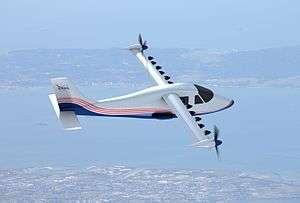Leading Edge Asynchronous Propeller Technology

The Leading Edge Asynchronous Propeller Technology (LEAPTech) project is a NASA project that is developing an experimental electric aircraft technology involving many small electric motors driving individual small propellers distributed along the edge of each aircraft wing.[1][2][3] Each motor can be operated independently at different speeds for optimized performance. Potential benefits include decreased reliance on fossil fuels, improved aircraft performance and ride quality, and aircraft noise reduction.[4]
Over the course of 2015, NASA researchers will perform ground testing of a 31-foot-span, carbon composite wing section with 18 electric motors powered by lithium iron phosphate batteries. Preliminary tests on an experimental wing, mounted on a specially modified truck driven at speeds up to 70 miles per hour across a dry lakebed at Edwards Air Force Base is planned for later in 2015. Preliminary testing, up to 40 mph, took place in January at Oceano County Airport on California’s Central Coast.[4]
The LEAPTech project began in 2014 when researchers from NASA Langley Research Center and NASA Armstrong Flight Research Center partnered with two California companies, Empirical Systems Aerospace (ESAero) in Pismo Beach and Joby Aviation in Santa Cruz. ESAero is the prime contractor responsible for system integration and instrumentation, while Joby is responsible for design and manufacture of the electric motors, propellers, and carbon fiber wing section.[4]
The truck experiment is a precursor to a development of a small X-plane demonstrator (the X-57 Maxwell) proposed under NASA’s Transformative Aeronautics Concepts program. Researchers hope to fly a piloted X-plane within the next couple years after removing the wings and engines from an Italian-built Tecnam P2006T and replacing them with an improved version of the LEAPTech wing and motors. Using an existing airframe will allow engineers to easily compare the performance of the X-plane with the original P2006T.[4]
References
- ↑ Jordan Golson (20 March 2015). "NASA Straps 18 Propellers to a Wing, Because Science". Wired.
- ↑ David Szondy (18 March 2015). "Could this 18-motor wing be the future of electric aircraft?". Gizmag.
- ↑ Grady, Mary (18 March 2015). "NASA's Electric Airplane Project Moves Forward". avweb.com. Aviation Publishing Group. Retrieved 19 March 2015.
- 1 2 3 4 Peter Merlin (16 March 2015). "LEAPTech to Demonstrate Electric Propulsion Technologies". NASA.